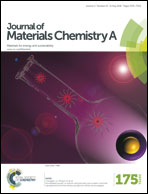Controlling uniform deposition of discharge products at the nanoscale for rechargeable Na–O2 batteries†
Abstract
Sodium–oxygen batteries are an attractive alternative for electrical energy storage applications because of their high-energy density and low cost. As a common challenge for all air-based battery systems, Na–O2 batteries also suffer from inefficient reversible formation of discharge products and poor cycling performance. Here, we report the design and synthesis of a binder-free air electrode composed of three-dimensional (3D) nitrogen-doped graphene aerogels (N-GAs). In this design, nitrogen-doped graphene aerogels grow directly on the Ni foam (3D N-GA@Ni) with a well-preserved interconnected 3D architecture. The Na–O2 cell with the 3D N-GA electrode is capable of large capacity (10 905 mA h gcarbon−1 at a current density of 100 mA gcarbon−1), long cycle life (over 100 cycles at 100 mA g−1 with a specific capacity limit of 500 mA h gcarbon−1) and high rate performance (over 50 cycles at 300 mA gcarbon−1). These properties are mainly attributed to the active N-group, which controls the uniform deposition of discharge products at the nanoscale and provides active sites for decreasing overpotential. This encouraging performance also offers a brand new approach to improve the electrochemical performance of Na–O2 batteries and other metal–air batteries.


 Please wait while we load your content...
Please wait while we load your content...